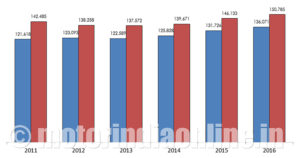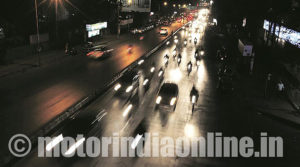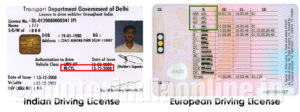MoRTH concern over growing casualties
The Ministry of Road Transport & Highways (MoRTH) has released a report on road accidents in India in 2016 prepared by the Transport Research Wing (TRW). According to the report, the number of persons killed in road accidents in India has increased to 150,785 as compared to 146,133 people in 2015.
The number suggests that at least 413 people died everyday in 1,317 road accidents. India accounts for the highest number of road deaths in the world, i.e., 10% of the global road accident deaths. Road accidents cost India about 3% of its gross domestic product every year.
The report has pointed out that the cities with a large population witnessed a majority of accidents. One of the key reasons for fatal accidents is the rapid increase in the number of registered vehicles. As per estimates, India has around more than 200 million registered motor vehicles, out of which 75% are two-wheelers/motorcycles.
Some of the key points highlighted by the study are:
(i) Almost half or 46.3% (69,851 persons) of the road fatality victims in 2016 were in the age-group of 18-35 years. The age group of 18-45 accounted for a share of 68.6% (103,409 persons) and the age group of 18-60 accounted for a share of 83.3% (125,583 persons) in the total road accident fatalities
(ii) Precisely 37.6% of total deaths occurred on other roads (city and village roads), whereas National Highways accounted for 34.5% of accident deaths and State Highways for 27.9%.
(iii) The Uttar Pradesh and Tamil Nadu have accounted for the maximum number of deaths in 2016, whereas Delhi had the highest number of deaths (1,591) due to road accidents in 2016. It is also important to highlight that Delhi has the highest number of private vehicles.
(iv) Drivers’ fault is the single most important factor responsible for road accidents (84%) and accident deaths (80.3%) on all roads in 2016.
(v) Over-speeding is the main reason for road accidents and deaths, i.e., 66.5% of all road accidents and 61% of accident deaths respectively. Usage of cellular phones caused over 2,000 deaths in 2016.
(vi) Two-wheelers (33.8%) accounted for the highest share in the total number of road accidents, followed by cars, jeeps and taxis (23.6%), trucks, tempos, tractors and other articulated vehicles (21%), buses (7.8%), auto rickshaws (6.5%) and other motor vehicles (2.8%). Also, 52,500 two-wheeler riders were killed in road accidents, i.e., 35% of accident deaths.
(vii) 40.3% of the vehicles involved in accidents had usage age of 0-5 years, while vehicle with usage age of 5-10 years accounted for 32.7% of accidents.
India is committed to reducing the number of road accidents and fatalities by 50% by 2020. However, there is need to take drastic measures to save precious human lives. Some of the key measures include:
- a) The Government should make investment in rail and bus transport to increase the share of public transport. It has been observed that road accidents in India are increasing owing to rapid urbanization and the highest motorization growth rate. Public transport will help reduce the number of road accidents and accidental deaths.
- b) Shared mobility like carpooling, bike-taxi, ride-sharing, etc., should be promoted to reduce congestion and traffic on the road. The data clearly shows that most of the accidents are happening on other roads. This can be avoided by reducing the number of vehicles.
- c) The Government should make the driving licence issuing process stringent and transparent. In India, there are only five vehicle categories of driving licence, compared to 15 vehicle categories in Europe.
- d) The Government should use vehicle telematics and install surveillance system on roads to monitor the speed limit of vehicles. Over-speeding vehicles should be fined heavily. This can be done in the public-private partnership (PPP) model by paying from the fines collected.
- e) The Government should link insurance premium of the vehicle or driver with the driving behaviour. A driver with bad traffic history should pay more insurance premium compared to safe drivers.


